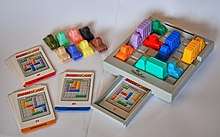Rush Hour (puzzle)
Rush Hour is a sliding block puzzle invented by Nob Yoshigahara in the 1970s. It was first sold in the United States in 1996. It is now being manufactured by ThinkFun (formerly Binary Arts).

ThinkFun now sells Rush Hour spin-offs Rush Hour Jr., Safari Rush Hour, Railroad Rush Hour, Rush Hour Brain Fitness and Rush Hour Shift, with puzzles by Scott Kim.
Game
The Regular Edition comes with 40 puzzles in 1 split up into 4 different difficulties, ranging from Beginner to Expert. The Deluxe Edition has a black playing board, card box in place of the board's own card tray and 60 new puzzles with an extra difficulty: the Grand Master, which is harder than Expert[1]. The Ultimate Collector's Edition also has a black playing board that can hold vehicles not in play and new way to display the current active card in a billboard like display. The Ultimate Collectors Edition also includes 155 new puzzles (with some of them being from card set 3) and a white limo. The Regular Version includes a travel bag. Extra puzzle card packs (in addition to the 40, 60 or 155 cards included with the game) are also available. Also both the Deluxe Edition and the Ultimate Collector's Edition comes with all new shiny vehicles variant with the Ultimate Collector's Edition ones being slightly altered in design. Then in 2011, the board was changed to black, like the Deluxe Edition but with a card try and the cards was also changed to have new levels and design to match the new board color[2].
Description
The board is a 6x6 grid with grooves in the tiles to allow cars to slide, card tray to hold the cards, current active card holder and an exit hole. The game comes with 16 vehicles (12 cars, 4 trucks), each colored differently, and 40 puzzle cards. Cars and trucks are both one square wide, but cars are two squares long and trucks are three squares long. Vehicles can only be moved along a straight line on the grid; rotation is forbidden. Puzzle cards, each with a level number that indicates the difficulty of the challenge, show the starting positions of cars and trucks. Not all cars and trucks are used in all challenges.
Objective
The goal of the game is to get only the red car out through the exit of the board by moving the other vehicles out of its way. However, the cars and trucks (set up before play, according to a puzzle card) obstruct the path which makes the puzzle even more difficult.
Expansions
Three official expansions, called "add-on packs", were released: Card Set 2, which comes with a red sports car that takes up 2 squares; Card Set 3, which comes with a white limo that takes up 3 squares; and Card Set 4, which comes with a taxi that takes up 2 squares. Each set also come with 40 new exclusive challenges—from Intermediate to Grand Master—that make use of the new vehicles in place of (or in addition to) the red car. Additionally, all three of the expansion packs will work with all three editions of the game: Regular Edition, the Deluxe Edition, and the Ultimate Collector's Edition. Also, like the Regular Edition of the game in 2011, the cards of all three expansions were also changed to have new levels and design to match the new board color of the Regular Edition.
An iOS version of the game was released in 2010.
Computational complexity on larger boards

When generalized so that it can be played on an arbitrarily large board, the problem of deciding if a Rush Hour problem has a solution is PSPACE-complete.[3] This is proved by reducing a graph game called nondeterministic constraint logic, which is known to be PSPACE-complete, to generalized Rush Hour positions. In 2005, Tromp and Cilibrasi [4] showed that Rush Hour is still PSPACE-complete when the cars are of size 2 only. They also conjectured that Rush Hour is still nontrivial when the cars are of size 1 only.
Most difficult configurations
The hardest possible initial configuration has been shown to take 93 steps. A shortest solution can be seen on the right.[5] If you count the necessary moves instead of the steps, the most difficult start configuration in this sense requires 51 moves.[6]
See also
- Combination puzzles
- Mechanical puzzles
- Klotski (or Chinese: Huarong Dao), a similar sliding block puzzle
References
- "Official Rush Hour Deluxe Edition Page". ThinkFun. Retrieved 2019-09-24.
- "Official Rush Hour Page Archive". 2011-07-09. Archived from the original on 2011-07-09. Retrieved 2019-09-24.
- Gary Flake and Eric Baum (2002). "Rush Hour is PSPACE-complete, or why you should generously tip parking lot attendants". Theoretical Computer Science. 270 (1–2): 895–911. doi:10.1016/S0304-3975(01)00173-6.
- John Tromp; Rudy Cilibrasi (2005). "Limits of Rush Hour Logic Complexity". arXiv:cs/0502068.
- Collette, Sébastien; Raskin, Jean-françois; Servais, Frédéric (May 2006). "On the Symbolic Computation of the Hardest Configurations of the RUSH HOUR Game". Computers and Games: 5th International Conference, CG 2006, Turin, Italy, May 29-31, 2006. Revised Papers. Lecture Notes in Computer Science. Turin, Italy. 4630: 220–233. CiteSeerX 10.1.1.91.3487. doi:10.1007/978-3-540-75538-8_20. ISBN 978-3-540-75537-1.
- Michael Fogleman (July 2018). "Solving Rush Hour, the Puzzle". How I created a database of all interesting Rush Hour configurations.